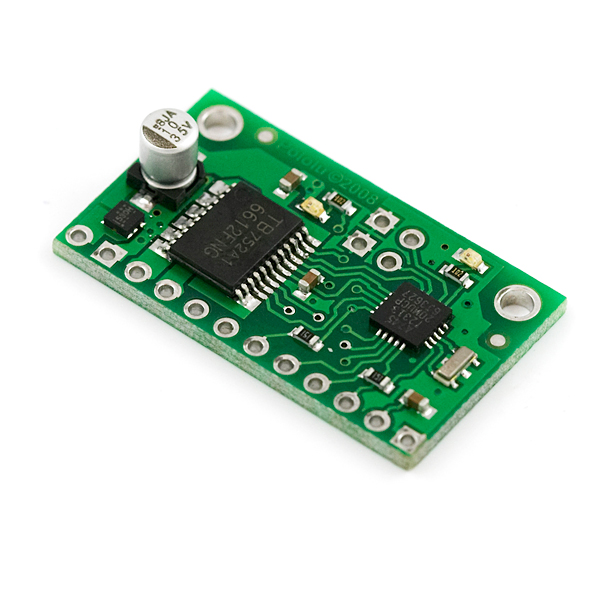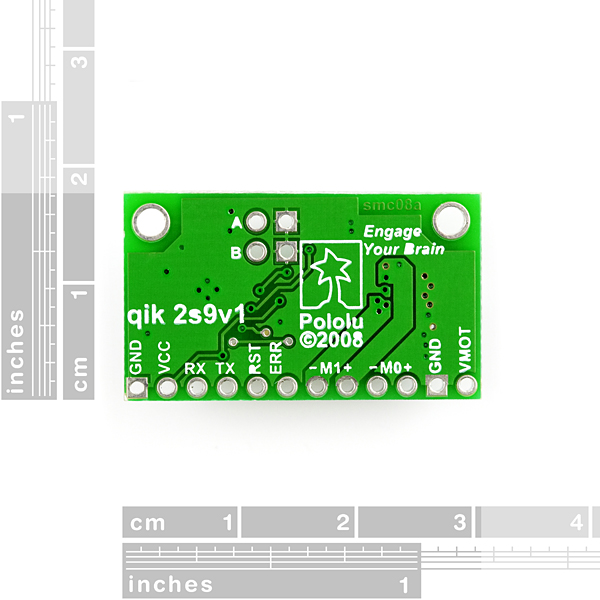Qik Dual Serial Motor Controller
The Qik Dual Serial Motor Controller is Pololu?s second-generation dual serial motor controller. The compact module allows any microcontroller or computer with a serial port (external RS-232 level converter required) to easily drive two small, brushed DC motors with full direction and speed control. It provides ultrasonic, 8-bit PWM speed control via an advanced, two-way serial protocol that features automatic baud rate detection up to 38.4 kbps and optional CRC error checking. Two status LEDs give visual feedback about the serial connection and any encountered error conditions, making debugging easy, and a demo mode allows easy verification of proper operation.
This controller also supports daisy-chaining the Qik to other Qiks and Pololu serial motor and servo controllers, allowing the control of an almost unlimited number of motors and servos with a single serial line.
It can also be configured to use 15.7 kHz, 7.8 kHz, or 3.9 kHz PWM frequencies.
General specifications:
- Motor driver: TB6612FNG
- Motor channels: 2
- Control interface: non-inverted TTL serial
- Minimum operating voltage: 4.5 V
- Maximum operating voltage: 13.5 V
- Continuous output current per channel: 1 A
- Peak output current per channel: 3 A
- Maximum PWM frequency: 32 kHz
- Minimum logic voltage: 2.7 V
- Maximum logic voltage: 5.5 V
- Reverse voltage protection?: Y
- Simple bidirectional control of two DC brush motors
- 4.5 V to 13.5 V motor supply range
- 1 A maximum continuous current per motor (3 A peak)
- 2.7 V to 5.5 V logic supply range
- Logic-level, non-inverted, two-way serial control for easy connection to microcontrollers or robot controllers
- Optional automatic baud rate detection up to 38400bps
- Two on-board indicator LEDs (status/heartbeat and serial error indicator) for debugging and feedback
- Serial error output to make it easier for the main controller to recover from a serial error condition
- Jumper-enabled demo mode allowing initial testing without any programming
- Optional CRC error detection eliminates serial errors caused by noise or software faults
- Optional motor shutdown on serial error or timeout for additional safety
- Supports daisy-chaining the qik to other qiks and Pololu serial motor and servo controllers, allowing the control of an almost unlimited number of motors and servos with a single serial line
- 0.70" x 1.2"
User's Guide- Serial Transmitter Utility for Windows
Qik Dual Serial Motor Controller Product Help and Resources
Core Skill: Soldering
This skill defines how difficult the soldering is on a particular product. It might be a couple simple solder joints, or require special reflow tools.
Skill Level: Noob - Some basic soldering is required, but it is limited to a just a few pins, basic through-hole soldering, and couple (if any) polarized components. A basic soldering iron is all you should need.
See all skill levels
Core Skill: Robotics
This skill concerns mechanical and robotics knowledge. You may need to know how mechanical parts interact, how motors work, or how to use motor drivers and controllers.
Skill Level: Competent - You may need an understanding of servo motors and how to drive them. Additionally, you may need some fundamental understanding of motor controllers.
See all skill levels
Core Skill: Programming
If a board needs code or communicates somehow, you're going to need to know how to program or interface with it. The programming skill is all about communication and code.
Skill Level: Rookie - You will need a better fundamental understand of what code is, and how it works. You will be using beginner-level software and development tools like Arduino. You will be dealing directly with code, but numerous examples and libraries are available. Sensors or shields will communicate with serial or TTL.
See all skill levels
Core Skill: Electrical Prototyping
If it requires power, you need to know how much, what all the pins do, and how to hook it up. You may need to reference datasheets, schematics, and know the ins and outs of electronics.
Skill Level: Competent - You will be required to reference a datasheet or schematic to know how to use a component. Your knowledge of a datasheet will only require basic features like power requirements, pinouts, or communications type. Also, you may need a power supply that?s greater than 12V or more than 1A worth of current.
See all skill levels
Comments
Looking for answers to technical questions?
We welcome your comments and suggestions below. However, if you are looking for solutions to technical questions please see our Technical Assistance page.
Customer Reviews
No reviews yet.






Works well and is small. Kinda wish the male header strip was already soldered to save me the trouble. Very compact, I like it.
Does anyone know if it's possible to hook up both channels to one motor to enable max 2.0 amps continuous? I'm guessing no but I can't find a specific answer in the documentation.
question, if i am using a brushless dc motor with encoder on it, do you hook up the encoder wires to this module? or to the arduino?
Do you mean "brushed" DC motor? The qik does not have built-in support for encoder feedback, so you would need to connect the encoder outputs to your Arduino and use it to close your feedback loop.
Does anyone know if it is possible to power this from the Arduino alone? Using the 5V for the motors, and the 3.3V for the logic? Or would it be better to power the motors with an external battery?
Unless it's a tiny motor, you should not be using the Arduino's regulated voltage to power it, and even if it is a tiny motor, you're potentially introducing quite a bit of noise onto the regulated power rail with the motor, which could cause all sorts of problems. I suggest you use a separate power source (the power source for your Arduino might work, depending on your motors).
Someone has created an Arduino library for the qik 2s9v1:
http://code.google.com/p/qik2s9v1arduino/